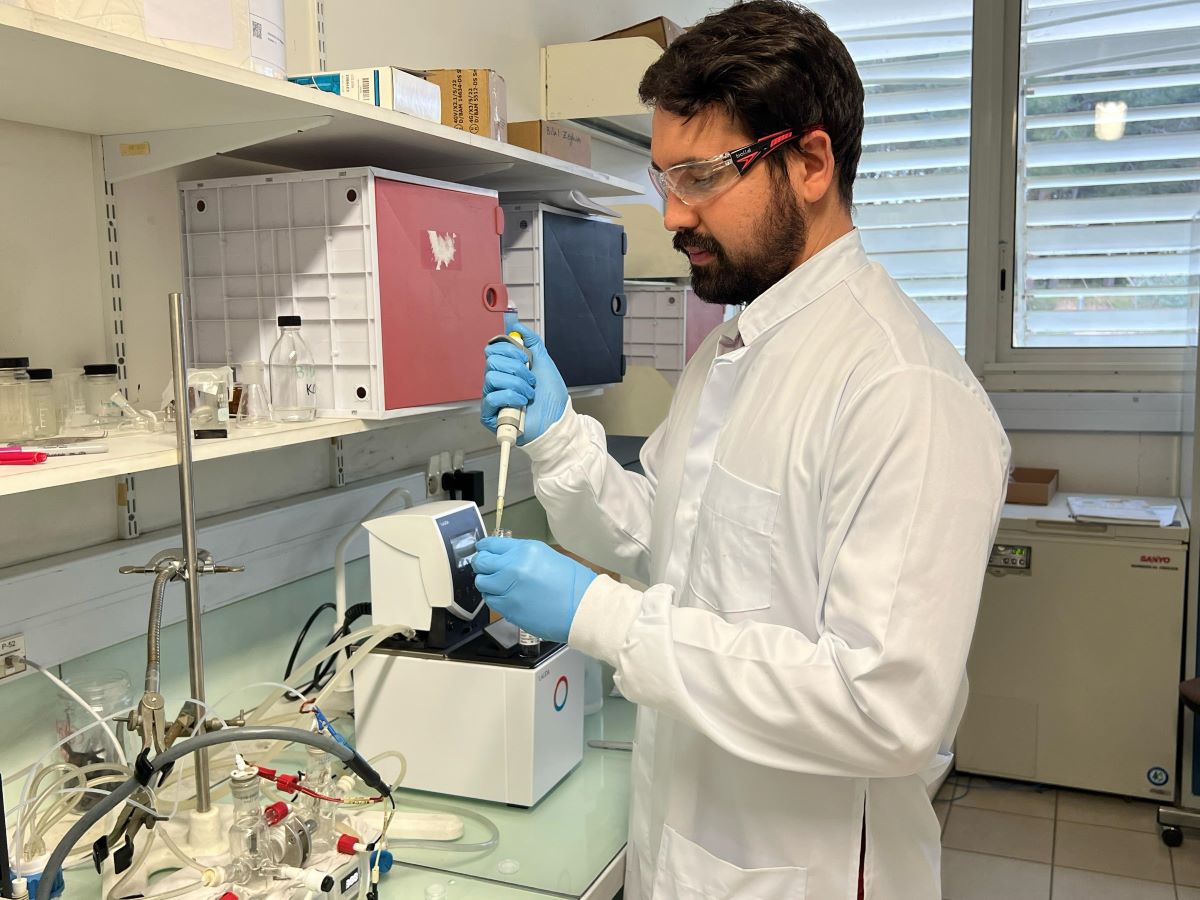

The study was conducted as part of Bruno Leuzinger da Silva’s doctoral research (photo: CINE)
In order to improve the performance of photoelectrocatalysts that act in the “separation” of H2, work carried out at a FAPESP-supported research center uses light and glycerol to eliminate unwanted compounds resulting from the reaction of these materials with organic molecules.
In order to improve the performance of photoelectrocatalysts that act in the “separation” of H2, work carried out at a FAPESP-supported research center uses light and glycerol to eliminate unwanted compounds resulting from the reaction of these materials with organic molecules.

The study was conducted as part of Bruno Leuzinger da Silva’s doctoral research (photo: CINE)
Agência FAPESP* – A group of researchers affiliated with the Center for Innovation in New Energies (CINE) has developed a method for purifying materials that is simple, economical and has a low environmental impact. The scientists have managed to improve the efficiency of a film that can be used in some green hydrogen production processes.
Known as mullite-type bismuth ferrite (Bi₂Fe₄O₉), the material has been used as a photoelectrocatalyst in the production of hydrogen by photoelectron oxidation, a process in which molecules of water or biomass derivatives are oxidized using sunlight as an energy source. The role of bismuth ferrite films in this process is to absorb light and drive the electrochemical reactions that “separate” the hydrogen from the original molecules (water, glycerol, ethanol, etc.).
However, the performance of these photoelectrocatalysts has been limited in the production of hydrogen due, among other factors, to the presence of unwanted compounds in the material itself, known as secondary phases. Now, research carried out by CINE members in the laboratories of the State University of Campinas (UNICAMP) in Brazil has brought a solution to the problem: a purification method that has managed to eliminate these unwanted compounds.
“The process significantly improved the material’s performance in the photoelectron oxidation of organic molecules,” says Pablo Fernández, professor at UNICAMP and co-author of the article reporting the discovery in the journal Electrochimica Acta.
CINE is an Engineering Research Center (ERC) supported by FAPESP and Shell; the research was conducted within its Advanced Energy Storage Division, based at UNICAMP, one of the four research divisions that make up the center.
“Although we’re still far from adequate performance for application in a real system, and several other aspects need to be improved, this is an important step towards the production of a cheap and sustainable material with applications in the production of green hydrogen and water purification [among others] by photoelectrochemical methods,” adds the scientist.
Luck favors the prepared
The study was conducted during Bruno Leuzinger da Silva’s doctoral research at UNICAMP’s Institute of Chemistry, under the supervision of Professor Ana Flávia Nogueira, also a member of CINE and co-author of the article. The student was testing the performance of bismuth ferrite films in the oxidation of glycerol molecules, with the aim of producing green hydrogen, when he observed that the material changed over time.
Later, detailed studies revealed the reason for the changes: when the material interacted with glycerol and light, it spontaneously purified itself. Finally, tests carried out on the purified films showed that they were better at producing hydrogen.
Based on this discovery, the team formulated the photoelectrochemical purification method published in the scientific article. In this method, the material to be purified is placed in contact with glycerol. When it is exposed to light, certain electrochemical reactions take place between the material and glycerol, and the secondary phases disappear.
The process basically uses electricity, light and glycerol, a renewable, biodegradable, non-toxic compound that is widely available as an abundant by-product of biodiesel production.
This discovery opens up opportunities for the development of high-purity, efficient and low-cost materials that can be used to drive various photoelectrochemical reactions that are important for applications such as the sustainable production of fuels and raw materials and the treatment of wastewater.
In addition to CINE, FAPESP participated in the work by supporting three other projects (20/04431-0, 21/02678-0 and 23/02929-9). The research also received funding from the National Council for Scientific and Technological Development (CNPq), the Coordination for the Improvement of Higher Education Personnel (CAPES), Shell and strategic support from the National Agency for Petroleum, Natural Gas and Biofuels (ANP).
The article “Photoelectrochemical Bi2Fe4O9 phase purification – Removing the phase Bi2O3 from Bi2Fe4O9/Bi2O3 thin films” can be read at: www.sciencedirect.com/science/article/abs/pii/S0013468625002154?via%3Dihub.
* With information from CINE
Republish
The Agency FAPESP licenses news via Creative Commons (CC-BY-NC-ND) so that they can be republished free of charge and in a simple way by other digital or printed vehicles. Agência FAPESP must be credited as the source of the content being republished and the name of the reporter (if any) must be attributed. Using the HMTL button below allows compliance with these rules, detailed in Digital Republishing Policy FAPESP.





